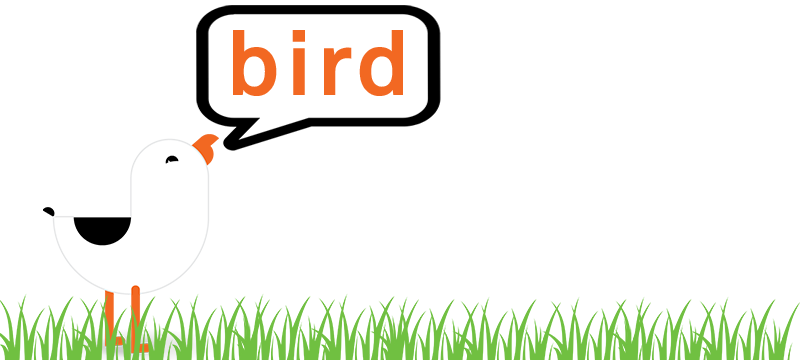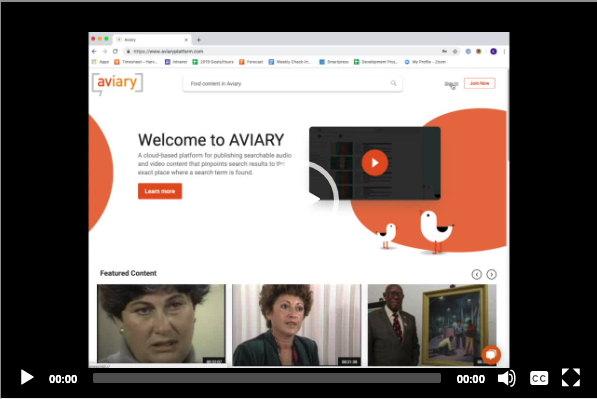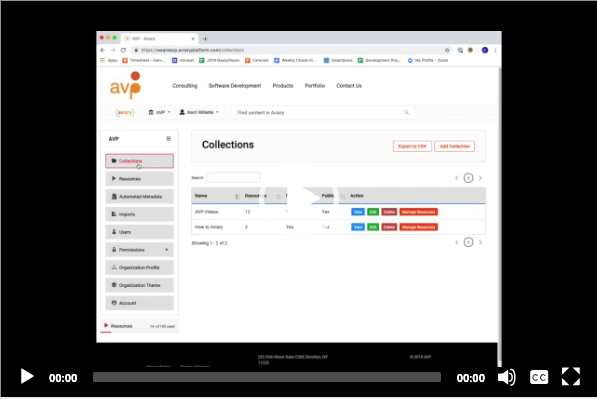How to Aviary: Lesson 3
17 June 2019
How to Create and Configure a Collection
Lesson3, Part 1: How to Create a Collection
Lesson 3, Part 2: How to Configure a Collection
Bird is the Word: The Closed Loop Problem
11 June 2019

Welcome back to the…. newly renamed Bird is the Word series (formerly named 99 Problems)! This series focuses on how our new streaming platform Aviary is changing the game. Want to start at the beginning? Read here. Otherwise, if you are ready to get back to it, let’s go!
Introduction
In my last post, I looked at the Lack of Democracy Problem. This reflected on the reality that features like in-audio search and in-video search have been available to very few. Aviary changes all that by offering these features and a whole lot more to anyone and everyone. In this post I am shifting the focus from who has access to what is being published.
Using text-based search as a reference, users wouldn’t expect to use one search engine for newspapers, another for websites, another for scholarly publications, and so on. We shouldn’t have this division when it comes to audio and video search either! When the what that is being published with in-audio and in-video search and navigation is restricted it creates a closed loop. The problem comes into play when we realize that in most use-cases users don’t want to search, find, and navigate content in closed loops. Users want their search results to show them a world of possibilities relating to their interests. The results should be presented so they can facet and prioritize quickly and decide what is useful and meaningful to them. So why does the closed loop problem happen?
Assume makes an…
There are implicit assumptions demonstrated by applications and platforms that utilize in-audio and in-video search which create the closed loop problem. What assumptions and which applications and platforms? Read on:
Assumption 1: Only one source of content is relevant. An example of this is TedTalks which publishes only TedTalks. This makes sense in terms of creating a brand but it isolates the content too – creating a closed loop. One of the major benefits of Aviary for consumers is that they can search across a broad array of content sources. One of the perks for publishers is that they can be discovered by audiences that hadn’t previously known of them.
Assumption 2: Only one type of content is relevant. For this example we can look to CastBox who has gotten a great deal of press over recent months about their in-audio search for podcasts. The loop is widened compared to the single source, but we’re still only playing within one type of content. Only publishers and consumers of podcasts benefit. Aviary doesn’t discriminate based on content type or favor one type of content over another. Publishers can publish broadly and consumers don’t have to go to 5 different applications to search for 5 different types of content.
Assumption 3: Only one media type is relevant. YouTube is a good example here. People that want to publish audio have to create a video out of their audio in order to publish it. On the flip side, CastBox only allows access to audio content. At best, these divisions create poor user experience. Aviary handles publishing and consumption of both audio and video with the nuance that each of these media types requires for publishers to offer compelling experiences and get consumers to engage fully.
Assumption 4: Everything is public. We can return to YouTube as an example here. YouTube assumes that everyone that uploads wants to publish publicly. For organizations with more complex permissions and access policies this won’t work. Aviary offers the public facing benefits of YouTube while bringing a robust set of permissions and access controls to meet the most demanding requirements. And not only do we offer this for the audio and video, but also for the transcripts and index text. If you can think up a permissions scenario, Aviary can do it.
Assumption 5: Everything is private. Players like Panopto and their Smart Search application are internal facing. Most organizations have complex permissions and access policies that require robust support for both public and private use-cases. Aviary responds to this reality by offering a sophisticated set of controls that allows publishers to define exactly when, where, and how their content is accessed while offering the same great user experience to both public and private users.
Assumption 6: Showing up in Google search results doesn’t matter. If you look at a platform like Kaltura, which features transcript creation, you’ll see that you won’t find those transcripts showing up in Google search results. In fact, most applications and platforms keep their metadata to themselves. It’s a form of keeping you and your users in their system. When publishers choose to make their content and transcripts public, Aviary exposes this metadata to Google so that search and discoverability is maximized.
Assumption 7: Everyone will come to them. Portals – systems that are built on the premise that users should come to them instead of them going to users – are a thing of the 90s and oughts, and that is where they should remain. Content and audience engagement requires fluidity in publishing and consumption. People need the ability to simultaneously centralize content and discovery while also being able to publish dynamically and broadly. On this front, every example application and platform given so far fails. Aviary implements a multi-faceted approach. We start by giving publishers the option to publish audio and video in Aviary from other streaming platforms. In other words, you can publish content that lives in YouTube, Vimeo, Soundcloud, and other places through Aviary, leverage the robust suite of Aviary features, and leave your content right where it lives. The benefits of breaking down silos without the need to migrate data. In addition to Aviary’s open-arms approach to other streaming platforms, publishers can use embed codes that allow for embedding the entire Aviary experience wherever you like. How sweet is that?!
Conclusion
Publishers no longer have to circumnavigate unnecessary walls. Consumers no longer have to deal with frustrating pointless divisions that only impede their ability to get to the information they want. Aviary breaks open the closed loop, turning it into a fluid and dynamic network and modernizing the publishing and search experience for audio and video content.
Managing Data In Spreadsheets
8 June 2019
In this tutorial, spreadsheets are positioned as a mechanism to help practitioners manage metadata more accurately, efficiently, and effectively. There are many opportunities to leverage sophisticated features in spreadsheet applications that allow you to work faster, smarter, and with greater accuracy towards a more robust metadata management system. The tutorial features instruction using Microsoft Excel. Self-directed exercises and practices worksheets are linked here:

